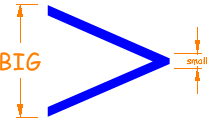Introduction to Inequalities
Inequality tells us about the relative size of two values.
Mathematics is not always about "equals"! Sometimes we only know that something is bigger or smaller
We call things like that inequalities (because they are not "equal")
Greater or Less Than
The two most common inequalities are:
Symbol
|
Words
|
Example Use
|
|---|---|---|
| > |
greater than
|
5 > 2
|
| < |
less than
|
7 < 9
|
They are easy to remember: the "small" end always points to the smaller number, like this:

Greater Than Symbol: BIG > small
... Or Equal To!
We can also have inequalities that include "equals", like:
Symbol
|
Words
|
Example Use
|
|---|---|---|
| ≥ |
greater than or equal to
|
x ≥ 1
|
| ≤ |
less than or equal to
|
y ≤ 3
|
Comparing Values
Practice >, < and = with Compare Numbers to 10
Learn more about Inequalities at
Less Than or Greater Than
( http://www.mathsisfun.com/algebra/inequality-solving.html )
Less Than or Greater Than
( http://www.mathsisfun.com/algebra/inequality-solving.html )
I find this post to be extremely useful. Especially the part about over examples. Thank you!
BalasPadamNice post, totally useful. Thanks~
BalasPadam